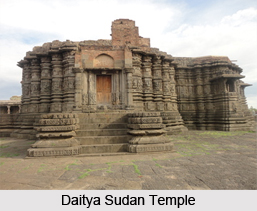 Daitya Sudan Temple is a medieval tabernacle of Lord Vishnu consisting of unique architecture of Chalukya Dynasty. But now, some of the architecture is present in the lower walls for its archaeological significance.
Daitya Sudan Temple is a medieval tabernacle of Lord Vishnu consisting of unique architecture of Chalukya Dynasty. But now, some of the architecture is present in the lower walls for its archaeological significance.
Location of Daitya Sudan Temple
Daitya Sudan Temple is located in Buldhana District of Maharashtra.
Mythological History of Daitya Sudan Temple
There is a mythological history that states that a demon by the name of Lonasur or Lavanasur used to reside in this locality along with his sisters. He was killed by lord Vishnu in his Daityasudan Avatar hence the name.
Geographical Extension of Daitya Sudan Temple
Daitya Sudan Temple measures 105 ft. long by 84.5 ft. broad. It is a tree chamber temple, the inner most being garbh grub, the sanctum sanctorum, where the idol of Lord Vishnu standing atop Lavanasur is there. The present day idol was made by bholse rulers of Nagpur after the original went missing. The second chamber is called "antaral" where individual puja was performed on the roof of this block one can see beautiful cravings of Puranic stories. The killing of Lavanasur by Lord Krishna and appearance of Dhar of Lonar; story of Kansa and Krishna, story of Narasimha and Hiran Kashyap and lastly raskrida are portrayed in the stone architecture.
Architecture of Daitya Sudan Temple
Daitya Sudan Temple was constructed by the kings of Chalukya Dynasty which ruled Central and Southern India between the 6th and 12th centuries. Daitya Sudan Temple belongs to the Hemadpanthi class and is built in the form of an irregular star. Daitya Sudan Temple features carvings similar to those seen at Khajuraho temples of Madhya Pradesh. The ceiling of Daitya Sudan Temple has carvings. The exterior walls of Daitya Sudan Temple are also covered with carved figures. The plinth of Daitya Sudan Temple is about 1.5 m in height and the unfinished roof suggests an intended pyramidal form for the tower.
Lord Vishnu of Daitya Sudan Temple
The deity of Daitya Sudan Temple is made of an ore with a high metal content that resembles stone.
Sculptural Style of Daitya Sudan Temple
The Daitya Sudan Temple at Lonar is the best example of the Hemadpanthi style. From the standing image of Lord Surya in the principal niche on the back of the temple it is conjectured that the temple was originally dedicated to the Sun god. However, in the present forms its Vaishnava temple of God Vishnu in its daityasudan avatar.
Chambers of Daitya Sudan Temple
The outermost chamber of Daitya Sudan Temple is called Sabhamandap which is meant for group offerings and performance. This portion as well as the entrance gate does not match the style and construction elements of the temple overall. The brickwork might have been added later to the damaged or unfinished temple, which may be attributed to various invasions post the 10th century.
Related Articles
Maharashtra, Indian State
History of Indian Temples
Temples in Sangli, Maharashtra
Tourism in Maharashtra
Kalaram Temple, Maharashtra
Western Ghats Mountain Range in India











